ARQ. GUSTAVO CARMONA. CREATING LANDSCAPES FOR THE SENSES
Gustavo considers architecture as a way of life instead of a job. In this way the passion, rigor and attention for detail are manifested in the production of an architecture that is sensitive to the immediate contexts that subscribe it.
His interest lies mainly in the generation of design strategies traduced into special moments and in the generation of experiences where the material and its intrinsic characteristics are manifested to strengthen the experience of the spaces.
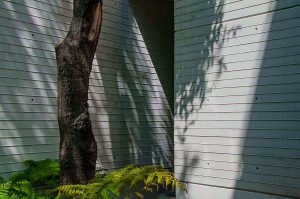
“Casa Bosque”, Mexico City.
Photography: Alberto Mora
What role do light, wind and sound play in the landscape perception?
If flowers, leaves, and scents are landscape architect’s elements, for me, light, wind, eco, and sound are landscape’s tools.
We don’t merely build surfaces or areas where to plant, we create scenarios where the door is not only an access, where a wall makes more than a divide, and becomes the one that receives the shadow of a tree and embraces it, it is where different sounds rebound and activate our sense of anticipation and depth.
This is when a landscape of phenomena or atmospheres starts to be created. I have been thinking a lot about perception and senses, in the great difference that exists between real, that physical, tangible, existent element; and reality, which is the perception that each one of us has of this real object, depending on the moment and the effects to which it subjected, in terms of light, wind, echo, etcetera; that in sum create a memory, an experience.
This is what I call “detailed atmosphere”, because it is being created, in a very conscious way, a scenery made of determined materials and very intentioned details, that provide possibilities for perception. Designing a landscape is synonymous to generating possibilities.
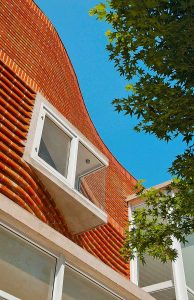
“Casa Valle”. Mexico City
Photography: Alberto Mora
When you conceive a project, how much do you use textures and colors to produce sensations through the atmosphere or the space that you envision?
I must confess that the color decision is hard for me; it is something complicated. To say: “Let’s make this building red”, why? I like to think that color is a consequence of the material. Instead of choosing a color, we try to choose an adequate material where the light can rest, to recognize the meaning of the place.
We have built brick houses where the red color is immediately perceived on the surface; but the one that is speaking is the material: its clay. The material tells you what it is, everything depends on the intention, the decision, and the awareness of knowing that every joint, quirk, or texture will have a different effect.

“Cámara de Duración”.
Photography: Jaime Navarro
There is a very important color: blue, the color of the sky and the sea, that are the things I like the most and the ones that produce in me a relationship with the atmosphere.
In both cases, that blue color is the result of the interaction between the light and the body of water or air, the amount of light that is absorbed is what determines the tone of blue.
I like to think that our architecture is related to that color, with its change during the day and its absence during night.
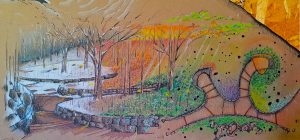
Landscape sketch.
Immersion Workshop, Vermont.
Illustration: Gustavo Carmona
How would you apply the concept of atmosphere as an architecture’s unit in landscape architecture?
There is no formula, but in my case, it necessarily brings me back to personal experiences, it is intimately related to what I believe about architecture, because architecture is lived by us; it is emotional, personal. An empty landscape is given to us and we start to create limits, we live in the cross section, not in the floor plan, nor the façade; our experience is in three dimensions.
The sum of those sequences generates the form of the moment and in itself the reality of the sensorial experience. As for me, to design a unit is to design a moment, which as a whole creates an atmosphere. The moment can be designed.
I have been recently in Capri, which is full of roads and trails: going up, going down, some of the trails are stone paved roads next to a cliff, and others are entirely covered by trees, in other moments the vegetation disappears.
The sum of those sequences and those moments is what it leaves in me a perception, a lecture of the place and how it behaves, where I don’t know its beginning nor its end, but its unit were definitely the different moments, and there can be moments that have much more emphasis.
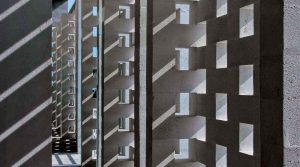
Veracruz Business Center.
Photography: Alberto Mora
What function do the sensations generated by the landscape play in the creation of the personal and the collective memory?
It is the main function. Juhani Pallasmaa says that “architecture and medicine are the most dignified professions of men, because they are dedicated to enhance the lives of the people”, in other words, in addition to provide shelter, architecture must provide something more. When it is just pragmatic, it turns sterile.
If in its conception it doesn’t have the understanding of housing the desires of the persons, then it will be merely a construction. If landscape doesn’t have that desire it will probably be just gardening. If at the end there isn’t a hearth enrichment, the meaning is lost.
I believe that it is a main role the one it has in the senses. In the world of data it is believed that the emotional is not measurable, but what is architecture but an act of emotion? And landscape architecture is, too.
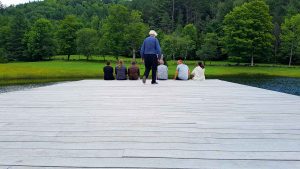
Moments in Vermont’s landscape with Juhani Pallasmaa.
Photography: Lisa Beltrán
What do you think is coming for landscape architecture in Mexico?
I compare what happens in Mexico with what I observe in other countries where I have worked. Landscape design is treated different there, and I think that a certain feeling of profession and excitement is lost.
I can’t tell you what will come, but I can tell you what I want to come and what I work for together with my collaborators and other colleagues: I want an architecture responsible for intimately connecting the context and the users through the profession of the materials; conscious of its intention, conceived and elaborated by people willing to explore through emotions, perception, and detail.








